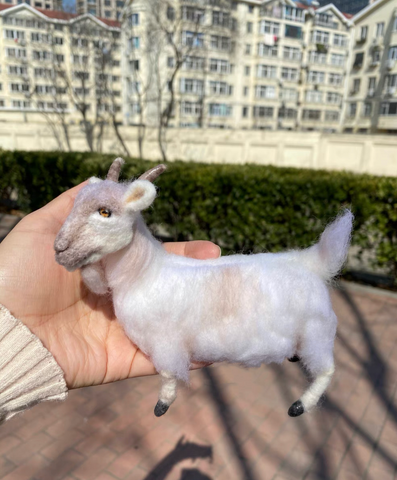
Needle felting is a popular craft that involves using a special barbed needle to tangle wool fibers together, creating a solid and compact form. One of the most popular things to needle felt is animals, and sheep are a favorite among crafters. In this article, we will explore the world of needle felted sheep, including their history, techniques, and some tips for beginners.
History of Needle Felting
Felting is one of the oldest textile arts, with evidence of felt making dating back to the Neolithic period. Needle felting, however, is a relatively modern technique that was developed in the mid-20th century. The technique was originally used in industry to make wool felt products such as hats and shoes, but it has since been adapted for use in the arts and crafts world.
One of the earliest known examples of needle felting in the craft world is the work of Japanese artist Sachiko Susa. In the 1980s, she began creating intricate needle felted sculptures of animals and plants, inspiring a new generation of crafters to explore the possibilities of this technique.
Today, needle felting is a popular craft that is enjoyed by people all over the world. The internet has played a big role in popularizing the craft, with online communities sharing tips, techniques, and inspiration for needle felted creations.
Techniques for Needle Felting Sheep
Needle felting sheep can be a bit more challenging than other animals due to their woolly coats. However, with a bit of practice and patience, anyone can create a cute and cuddly needle felted sheep.

Here are some techniques to keep in mind when needle felting sheep:
-
Start with a wire armature: An armature is a framework that provides structure to your needle felted creation. For a sheep, a wire armature can help you create the shape of the body and legs before you start adding wool fibers.
-
Layer your wool fibers: Sheep have a thick and fluffy coat, so layering your wool fibers is important to create a realistic look. Start with a base layer of wool, then add more fibers in the direction of the sheep's coat. Use a variety of colors to create depth and texture.
-
Use a variety of needles: Different needles have different sizes and shapes of barbs, which can affect the density and texture of your needle felted creation. Use a larger needle for the initial shaping and a smaller needle for finer details.
-
Pay attention to proportions: Sheep have a distinctive body shape, with a round belly and narrow legs. Pay attention to the proportions of your sheep to create a realistic look.
Tips for Beginners

needle felted sheep kit for beginners with tutorials
If you're new to needle felting, creating a sheep can be a great way to get started. Here are some tips to help you get started:
-
Start with a simple design: A basic, standing sheep is a great project for beginners. As you become more experienced, you can add more details and complexity to your designs.
-
Practice your techniques: Before you start your final project, practice your needle felting techniques on a small piece of wool. This will help you get a feel for the needle and how the fibers interact.
-
Use high-quality materials: High-quality wool fibers and needles can make a big difference in the quality of your needle felted creations. Look for wool that is specifically designed for needle felting and invest in a variety of needles.
-
Be patient: Needle felting can be a slow and meticulous process, so be patient with yourself and your project. Take breaks if you need to and don't rush the process.
Examples of Needle Felted Sheep
There are countless examples of needle felted sheep out there, ranging from realistic to whimsical. Here are a few examples to inspire you

-
Realistic sheep: These needle felted sheep are incredibly lifelike, with a detailed wool coat and realistic features such as hooves and facial expressions. They are often made using a wire armature to create the shape of the body, and then layers of wool are added to create the woolly coat.
-
Cartoon sheep: These needle felted sheep are often more whimsical and playful, with exaggerated features and bright colors. They are great for adding a bit of fun to your home décor or as a cute gift for a child.
-
Miniature sheep: These needle felted sheep are tiny and adorable, often no bigger than a few inches tall. They can be used as part of a larger scene or as cute little decorations on their own.
-
Fantasy sheep: These needle felted sheep take inspiration from fantasy and mythology, with features such as horns and wings. They are a great way to showcase your creativity and imagination.
-
Sculptural sheep: These needle felted sheep are more like works of art than toys or decorations. They often have intricate details and a unique design that makes them stand out.

Conclusion
Needle felting sheep is a fun and rewarding craft that anyone can enjoy. Whether you're a beginner or an experienced crafter, there are plenty of techniques and styles to explore. By following the tips and techniques outlined in this article, you can create your own needle felted sheep that is sure to bring a smile to your face. So grab your wool fibers and needle, and get started on your next needle felting project!
